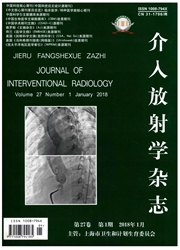

 中文摘要:
中文摘要:
目的观察和评价AZ31镁合金血管支架置入后的内膜增生情况。方法将24枚采用激光雕刻制成的AZ31镁合金支架置入12只Beagle犬的双侧髂外动脉内.按支架置入术后时间将动物分为1、3、6个月i组,每组4只。在相应时间点取支架段血管进行HE染色,观察镁合金支架置入后内膜增厚程度、新生内膜成分及形态特点。结果AZ31镁合金支架置入术后1、3、6个月均产生了较明显的内膜增生.内膜一中膜比值分别为1.17±0.06、1.64±0.09、0.91±0.05.相比1个月和6个月,术后3个月时内膜增生最为明显(P〈0.05),且内膜增厚以支架支撑杆周围为著.新生内膜主要成分为排列紊乱的血管平滑肌细胞及细胞外基质,在置人术后早期可见少量的炎性细胞。结论虽然AZ31镁合金血管支架具有可降解性,但其置人后仍出现不同程度内膜增生.且以3个月时最为明显。
 英文摘要:
英文摘要:
Objective To observe and evaluate the characteristics of neointima proliferation after implantation of AZ31 magnesium stent. Methods Under fluoroscopic guidance a total of 24 AZ31 magnesium stents were implanted in bilateral external iliae arteries of 12 beagles. The animals were randomly and equally divided into 3 groups according to the postoperative time (1, 3 and 6 months after stent implantation). Stent segments of the arteries were removed at 1, 3 and 6 months respectively. Cross-sections with l0 - 15 p~m thickness were prepared by a cutting grinding system for hard specimens. The sections were stained by haematoxylin- eosin staining for computer- assisted histomorphometric analyses. Intima-to- media ratio was used to evaluate neointima proliferation. All quantitative measurements were reported as mean _+ SD, and comparisons between the same values at different time points were performed with a 2-tailed paired t-test. A value of P 〈 0.05 was considered statistically significant. Results Neointima hyperplasia which caused in- stent stenosis was found in all beagles of the three groups, which was more significant in the areas surrounding the stent struts in 3 months group when compared with that of one month or 6 months group (P 〈 0.05). The neointima was composed of vascular smooth muscle cell in tangle array and extracellular matrix, and mild inflammatory response was only seen in surrounding area of the struts at one month and 3 months groups. Conclusion As foreign bodies are similar to non-biodegradable stents, the AZ31 magnesium stents can also induce neointimal proliferation before total degradation, leading to in- stent lumen loss, and the proliferation is most significant at 3 months after stent implantation. (J Intervent Radiol, 2014, 23: 132-135)
 同期刊论文项目
同期刊论文项目
 同项目期刊论文
同项目期刊论文
 期刊信息
期刊信息
